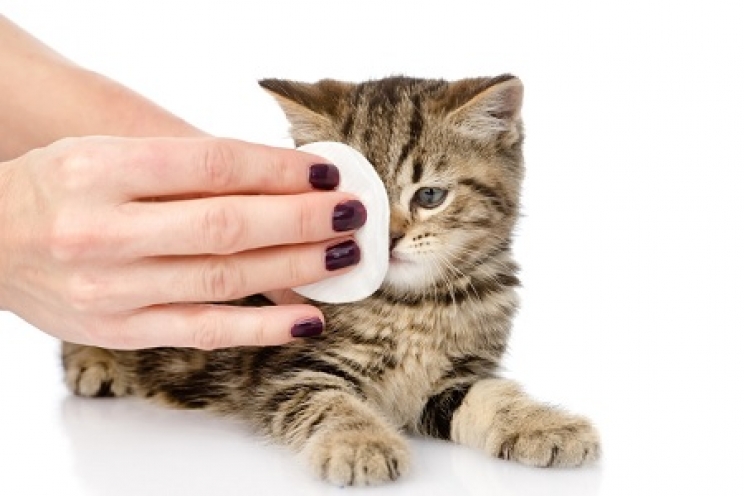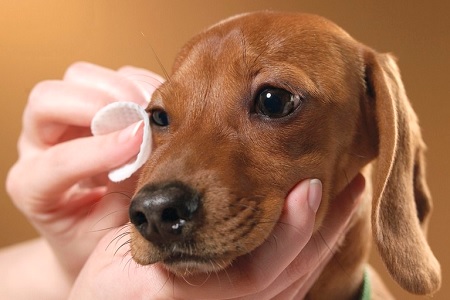What a nuisance those dark spots under the eyes of our four-legged friend! Not to mention how unsightly white furred dogs and cats look like with these spots. Moreover, you will have to perform a thorough cleaning of the eyelids in association with specific therapies. This is why it is important to be familiar with the manoeuvres to get our animals used to letting their eyes be cleaned, with the right products and techniques.
When should the eyes be cleaned?
Speaking from a purely aesthetic point of view, we must consider brachycephalic dogs and cats, that is, all those breeds that have a rather flattened muzzle. Among cats, Persian represents the typical example, whilst in dogs we can mention, for example, Poodles, Maltese, Shi Tzu, Bichon frisè. The particular shape of the head, with a very short nose and large eyes, makes it difficult to hold back tears, which come out more frequently. In the long run, the tear fluid, often reddish or brownish, accumulates on the hair around the eyes, crusting and making it rather difficult to remove.
For cats, the situation may change slightly compared to the dog, considering their proverbial attention to personal hygiene. It is no coincidence they spend time washing thoroughly every inch of their body until they have removed all traces of dirt. However, it may happen that some cats are unable to clean their eyes with as much care, so it is up to us owners to clean them in the right way.
On the contrary, eye and eyelid hygiene may require greater attention of non-aesthetic purposes. For example, the most frequent situations can include:
- Irritation caused by dust, soil and sand
- Discomfort caused by detergents, perfumes and aggressive substances
- Conjunctivitis, which involves the production of thick tears, with mucus and crusting
- Dry keratoconjunctivitis, which causes little or no watery eyes, facilitating eye irritation
What products can we use?
On the market, you may find many specific products for cleaning the eyes of our animals, available in any pet shop. If, on the other hand, the dog and the cat have particular problems, such as conjunctivitis, it will be our veterinarian to indicate which product to combine with the drug therapy.
One factor that we must always keep in mind when we talk about our four-legged friends, is that in some respects they are different from us. In particular, their skin has a different pH from ours and is also much more sensitive, (although all that hair can make us believe otherwise). This is why it is important to avoid using products chosen at random or taken from our medicine cabinet, without considering any contraindications for dogs and cats.
If we are undecided about the product to choose, we can safely use other practical and economic solutions, such as:
- Warm water
- Physiological water
- Boric water
- Chamomile infusion
The only controversial aspect related to these products is that they are often not used in full attention to sterility. Physiological and boric water, if stored properly, should not create problems. On the contrary, plain water or chamomile should be boiled before using them, after letting them cool. All this, of course, as long as you apply them with sterile, possibly soft gauze.
An equally valid alternative is represented by the solutions on the market, specific for all needs, such as wipes and cleansing gels, often also equipped with disinfectant, decongestant or soothing properties.
The correct manoeuvres
We must consider that the eyes, as well as the ears, are a very sensitive area for dogs and cats, who often try to escape our touch. For this reason, it is very important to be able to get our animals used to being manipulated since they are puppies, making sure that they associate the moment of cleaning with something very pleasant without running away.
If, on the other hand, we approach these delicate areas of our friend only to “tinker” with cotton balls or other unpleasant tools, every time we try to touch his eyes, he will think that we have something different in mind instead of caresses. What we should do, however, is to make sure that he gets used to the contact, often stroking his head, without forgetting to pass his hand over his face too.
Here is how we should proceed:
- Let's wash our hands with soap and water, to prevent the germs from reaching the cat's eyes;
- We take soft gauze or cotton balls;
- We apply the product we have chosen on the gauze;
- Gently pass the gauze or cotton ball over the eye, starting from the inside corner and going outwards. Let's avoid putting too much pressure; if there is a strong incrustation, we proceed with a single pass, let the liquid soften the dirt and then repeat, changing gauze It is very important to avoid using the same gauze for both eyes, because in the presence of infections we could transfer the germs from one eye to another.
One aspect that can be annoying, especially if we refer to the cat, is that it can run away or attack us. For this reason, we must learn to with precaution since the beginning. Cats hate feeling forced, so it is unthinkable to grab them without receiving at least a couple of scratches. Since the area that interests us is that of the face, we must simply position ourselves behind him, without grasping him, but slowly starting to show him what we are holding.











